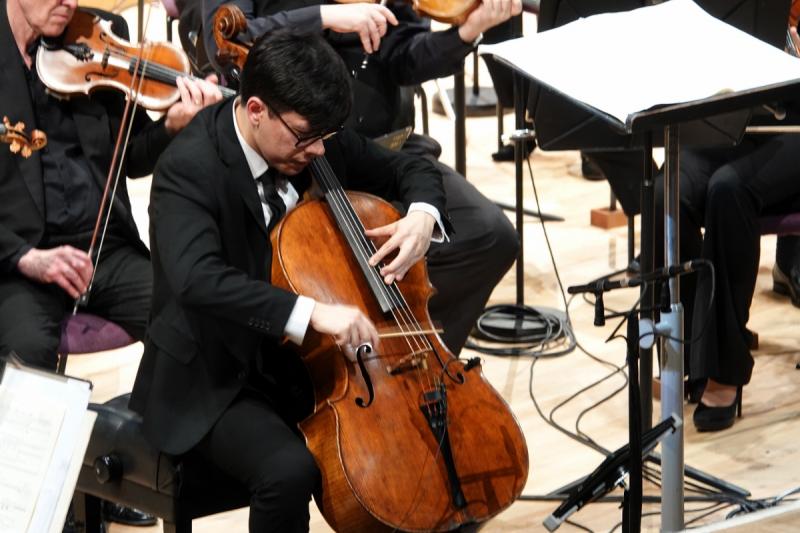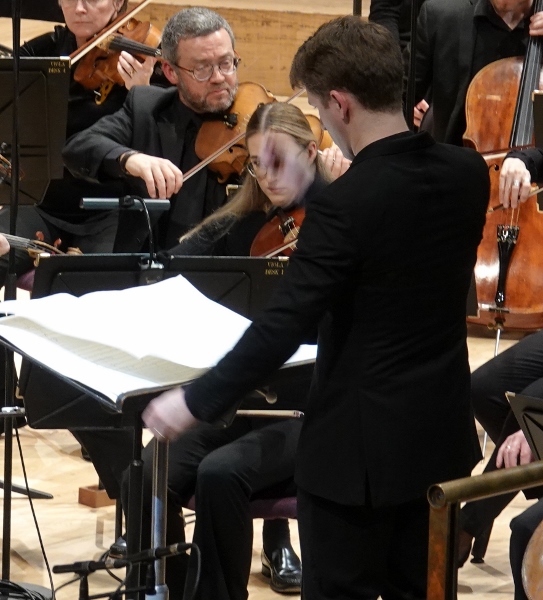Fung, BBC Philharmonic, Weilerstein, Bridgewater Hall, Manchester review - clever and comical | reviews, news & interviews
Fung, BBC Philharmonic, Weilerstein, Bridgewater Hall, Manchester review - clever and comical
Fung, BBC Philharmonic, Weilerstein, Bridgewater Hall, Manchester review - clever and comical
First UK performance of new cello concerto by Katherine Balch given with uncanny skill

Placing the UK premiere of Katherine Balch’s whisper concerto (for cello and orchestra) after Haydn’s Symphony No. 100 was probably an inspired idea from the BBC Philharmonic and conductor Joshua Weilerstein.
In its day, the so-called “Military” Symphony was not only striking on account of its use of novel instrumental effects – the “Turkish music” sound of triangle, cymbals and big drum for one, and clarinets (heard, military-band style, alongside oboes and flute) for another – but the clever and comical way they were brought into a context that was otherwise seemingly orthodox and almost academically conventional.
 Weilerstein played it in a manner that we don’t often get with Haydn symphonies now: far from paring string forces down to the dimensions most frequently on offer in the composer’s own day, he had 40 string players around him and also the plummy sound of modern timpani, albeit hit with hard sticks. The second violins were concealed behind their first violin colleagues and only rarely audible when their line had imitative figures in it, indeed the entire texture was top-dominated and solid.
Weilerstein played it in a manner that we don’t often get with Haydn symphonies now: far from paring string forces down to the dimensions most frequently on offer in the composer’s own day, he had 40 string players around him and also the plummy sound of modern timpani, albeit hit with hard sticks. The second violins were concealed behind their first violin colleagues and only rarely audible when their line had imitative figures in it, indeed the entire texture was top-dominated and solid.
Those “Turks” made their presence heard in loudly assertive style when they gatecrashed the decorous r
efinement of the second movement’s allegretto, but after the careful dance steps of the minuet (soldierly types doing their best to remember their ballroom lessons, perhaps?) in the conclusion of the final movement they had grown more civilised and able to join in the jolly extroversions of its presto.
The solo of Katherine Balch’s concerto was played by Zlatomir Fung, the American cellist of Bulgarian and Chinese heritage who premiered it last year in Texas (it was co-commissioned by the BBCX with the Dallas Symphony and Staatstheater Darmstadt and had its European premiere in Darmstadt last year, too).
It looks conventional at first: three movements, each with its title in Italian. But then you notice that the Andante is agitato, the Presto is dolcissimo, and the finale Andante di nuovo – well, that has its own surprises, too.
As Balch herself comments in her note, “how can an andante be agitato? A presto dolcissimo?” She’s going to show us how. Convention might dictate that the composer of a cello concerto is going to agonise over how to make the soloist heard against the texture of a modern orchestra (and she specifies 50 strings minimum). In this case there were five percussionists, making a dazzling variety of noises, as well as the weight of full brass and wind and a prepared piano … so how to do it? Amplification, stupid. Zlatomir Fung had his own private sound system, with a couple of small speakers in front of him, and I’m told there was “some manipulation of sound” also. And since he had to play for a considerable length of time with a chopstick in place of his bow, it clearly helps to be able to make unusual sounds audible.
Balch is very precise in her requirements, not only of the soloist but of the orchestra, asking for variations on playing methods such as pizzicato and flutter-tonguing, and I could see Ian Buckle the piano player almost disappearing inside his instrument in order to fulfil her bidding.
For the soloist there are extreme demands of virtuosity, which Fung, I’m sure, met with uncanny skill, and when playing in the normal way his tone was serene and beautiful (the orchestra’s assistant principal cello, Maria Zachariadou, eloquently had her moment, too, as she took over the solo’s melodic role in the third movement while he was busily occupied with other things).
So what does it all amount to? The piece is a tribute to Ligeti’s Cello Concerto and its “whispering cadenza”, and she says she aims to make the sounds “extremely strange”, while using “almost conventionally tonal” melodies, fragments of free jazz and a kind of chorale effect (which becomes heavily obvious towards the end of the piece) as well. There’s also intentional “disorder” and “shameless noise” – those were clear enough, with a really weird sequence of pops and rattles from the percussionists while the soloist was doing his thing with the chopstick. But to the listener the underlying language is one of tonality and concord. It’s harmony, Jim, but not as we know it, and that is both seriously amusing and unnervingly reassuring.
Manipulating sound and confounding expectations are the essence of compositional skill, and for the second part of the concert we had a masterclass in the way to do it, in Mozart’s Symphony no. 41 (the so-called “Jupiter”) – the orchestral strings back to the dimensions heard in the Haydn earlier. Joshua Weilerstein (pictured above right) decided to make it into a bit of a lecture-demonstration, too, and played us first the finale of Michael Haydn’s Symphony no. 28, a piece which Mozart apparently took ideas from as to how fugal technique could be used inside the structure of a classical symphony, while doing it so many times better with the last movement of the “Jupiter”. Mediocrity imitates, while genius steals, as they say.
The opening was vigorously and neatly articulated, with Yuri Torchinsky back in the leader’s chair (and the violins behind him playing delightfully in the Andante cantabile, too). The minuet was smooth and delicate, and the finale gloriously clear, with brassy horns and energy on all sides.
Sadly, the prospect of music by an unknown name was enough to deter Manchester’s Saturday night concert-goers in droves, despite the mainstream symphonies to sugar the pill.
- Recorded for broadcast on Radio 3 on 21 February and subsequently on BBC Sounds
- More classical and opera reviews on theartsdesk
rating
Share this article
more Classical music
 Queyras, Philharmonia, Suzuki, RFH review - Romantic journeys
Japan's Bach maestro flourishes in fresh fields
Queyras, Philharmonia, Suzuki, RFH review - Romantic journeys
Japan's Bach maestro flourishes in fresh fields
 Classical CDs: Swans, hamlets and bossa nova
A promising young pianist's debut disc, plus Finnish mythology and a trio of neglected British composers
Classical CDs: Swans, hamlets and bossa nova
A promising young pianist's debut disc, plus Finnish mythology and a trio of neglected British composers
 Christian Pierre La Marca, Yaman Okur, St Martin-in-The-Fields review - engagingly subversive pairing falls short
A collaboration between a cellist and a breakdancer doesn't achieve lift off
Christian Pierre La Marca, Yaman Okur, St Martin-in-The-Fields review - engagingly subversive pairing falls short
A collaboration between a cellist and a breakdancer doesn't achieve lift off
 Ridout, Włoszczowska, Crawford, Lai, Posner, Wigmore Hall review - electrifying teamwork
High-voltage Mozart and Schoenberg, blended Brahms, in a fascinating programme
Ridout, Włoszczowska, Crawford, Lai, Posner, Wigmore Hall review - electrifying teamwork
High-voltage Mozart and Schoenberg, blended Brahms, in a fascinating programme
 Sabine Devieilhe, Mathieu Pordoy, Wigmore Hall review - enchantment in Mozart and Strauss
Leading French soprano shines beyond diva excess
Sabine Devieilhe, Mathieu Pordoy, Wigmore Hall review - enchantment in Mozart and Strauss
Leading French soprano shines beyond diva excess
 Špaček, BBC Philharmonic, Bihlmaier, Bridgewater Hall, Manchester review - three flavours of Vienna
Close attention, careful balancing, flowing phrasing and clear contrast
Špaček, BBC Philharmonic, Bihlmaier, Bridgewater Hall, Manchester review - three flavours of Vienna
Close attention, careful balancing, flowing phrasing and clear contrast
 Watts, BBC Symphony Orchestra and Chorus, Bignamini, Barbican review - blazing French masterpieces
Poulenc’s Gloria and Berlioz’s 'Symphonie fantastique' on fire
Watts, BBC Symphony Orchestra and Chorus, Bignamini, Barbican review - blazing French masterpieces
Poulenc’s Gloria and Berlioz’s 'Symphonie fantastique' on fire
 Bell, Perahia, ASMF Chamber Ensemble, Wigmore Hall review - joy in teamwork
A great pianist re-emerges in Schumann, but Beamish and Mendelssohn take the palm
Bell, Perahia, ASMF Chamber Ensemble, Wigmore Hall review - joy in teamwork
A great pianist re-emerges in Schumann, but Beamish and Mendelssohn take the palm
 First Persons: composers Colin Alexander and Héloïse Werner on fantasy in guided improvisation
On five new works allowing an element of freedom in the performance
First Persons: composers Colin Alexander and Héloïse Werner on fantasy in guided improvisation
On five new works allowing an element of freedom in the performance
 First Person: Leeds Lieder Festival director and pianist Joseph Middleton on a beloved organisation back from the brink
Arts Council funding restored after the blow of 2023, new paths are being forged
First Person: Leeds Lieder Festival director and pianist Joseph Middleton on a beloved organisation back from the brink
Arts Council funding restored after the blow of 2023, new paths are being forged
 Classical CDs: Nymphs, magots and buckgoats
Epic symphonies, popular music from 17th century London and an engrossing tribute to a great Spanish pianist
Classical CDs: Nymphs, magots and buckgoats
Epic symphonies, popular music from 17th century London and an engrossing tribute to a great Spanish pianist
 Sheku Kanneh-Mason, Philharmonia Chorus, RPO, Petrenko, RFH review - poetic cello, blazing chorus
Atmospheric Elgar and Weinberg, but Rachmaninov's 'The Bells' takes the palm
Sheku Kanneh-Mason, Philharmonia Chorus, RPO, Petrenko, RFH review - poetic cello, blazing chorus
Atmospheric Elgar and Weinberg, but Rachmaninov's 'The Bells' takes the palm

Add comment